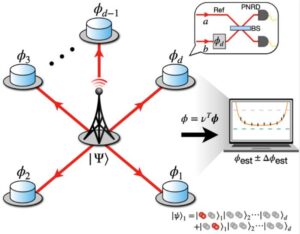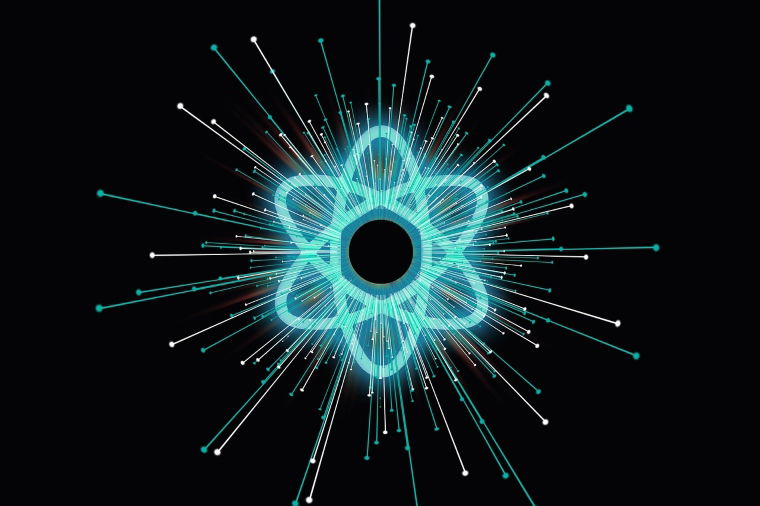Korean Institute of Science and Technology (KIST) scientists have successfully demonstrated the world’s first ultra-precise, ultra-sensitive distributed quantum sensor network sensitive enough to approach the Heisenberg limit, where distinguishing the desired signal from the noise becomes impossible.
The approach is also among the first in the field to conduct experiments that simultaneously employ multiple quantum entangled photons, enabling unprecedented sensitivity and precision beyond single-entangled-photon approaches.
While previous approaches to a distributed quantum sensor network aimed to increase measurement precision, the new approach is the first to leverage this unprecedented level of precision for higher-resolution imaging. Using several quantum sensors in concert is similar to astronomers employing several observatories to measure a single phenomenon with more detail than any individual observatory could achieve on its own.
The research team behind the accomplishment suggests their approach could improve applications from space observation to medical imaging by offering previously unattainable fine details collected from multiple sensors working together rather than a lone sensor.
In a statement detailing the work, team leader Dr. Hyang-Tag Lim of the Center for Quantum Technology at the Korea Institute of Science and Technology (KIST) said the team leveraged a specialized quantum-entangled state, known as the “multi-mode N00N state,” to achieve previously unattainable precision and resolution.
 Generation of multi-mode N00N states using Bell states generated by the Sagnac interferometer and transmission of the generated entanglement states to each mode. Estimation of the average of two phases by local measurements after phase encoding. Image
Generation of multi-mode N00N states using Bell states generated by the Sagnac interferometer and transmission of the generated entanglement states to each mode. Estimation of the average of two phases by local measurements after phase encoding. Image
Credit: Korea Institute of Science and Technology (KIST).
Quantum entanglement is a phenomenon where changes to one photon are mirrored by its entangled partner instantaneously, regardless of distance. In this application, entangling photons enabled simultaneous detection of multiple parameters.
According to the statement, the KIST team’s distributed sensor network surpasses the Standard Quantum Limit (SQL) by using an entangled “multi-mode N00N” state, enabling correlated measurement of multiple parameters with enhanced phase sensitivity. In experiments, the researchers created a two-photon multi-mode N00N state entangled across four distinct path modes. The team said this distribution allowed them to “measure” two different parameters simultaneously.
When evaluating the test results, the researchers determined that this first-of-its-kind setup achieved “approximately 88% higher precision (2.74 dB improvement)” when compared to currently available methods.
 (a) Probability distribution as a function of phase value, (b) Fisher information as a function of phase value, and (c) average estimation result of two phases. Achieved 88% (2.74 dB) improvement in sensitivity over the classical limit, close to the Heisenberg limit. Image Credit: Korea Institute of Science and Technology (KIST).
(a) Probability distribution as a function of phase value, (b) Fisher information as a function of phase value, and (c) average estimation result of two phases. Achieved 88% (2.74 dB) improvement in sensitivity over the classical limit, close to the Heisenberg limit. Image Credit: Korea Institute of Science and Technology (KIST).
The researchers said this result demonstrated sensitivity performance approaching the Heisenberg limit “not only in theory but also in experiment.” They added that the accomplishment demonstrated that “even the smallest physical changes can be detected with high sensitivity.”
“This achievement marks an important milestone, demonstrating the potential of practical quantum sensor networks based on quantum entanglement technology,” said Dr. Hyang-Tag Lim.
When discussing potential applications, Dr. Lim’s team said the achievement has a “broad potential for applications” across a wide range of fields. These include the life sciences, precision medicine, semiconductor manufacturing, and space observation.
 (a) Probability distribution as a function of phase value, (b) Fisher information as a function of phase value, and (c) average estimation result of two phases. Achieved 88% (2.74 dB) improvement in sensitivity over the classical limit, close to the Heisenberg limit. Image Credit: Korea Institute of Science and Technology (KIST).
(a) Probability distribution as a function of phase value, (b) Fisher information as a function of phase value, and (c) average estimation result of two phases. Achieved 88% (2.74 dB) improvement in sensitivity over the classical limit, close to the Heisenberg limit. Image Credit: Korea Institute of Science and Technology (KIST).
“For instance, it could enable high-clarity imaging of subcellular microstructures that are difficult to resolve with conventional microscopes, the detection of nanometer-scale defects in semiconductor circuits, and the precise observation of distant astronomical structures that would otherwise appear blurred through ordinary telescopes,” they explained.
“In the future, when combined with silicon-photonics-based quantum chip technology, it could be applied to a wide range of everyday applications,” Dr. Hyang-Tag Lim concluded.
The study “Distributed quantum sensing with multi-mode N00N states” was published in Physical Review Letters.
Christopher Plain is a Science Fiction and Fantasy novelist and Head Science Writer at The Debrief. Follow and connect with him on X, learn about his books at plainfiction.com, or email him directly at christopher@thedebrief.org.


